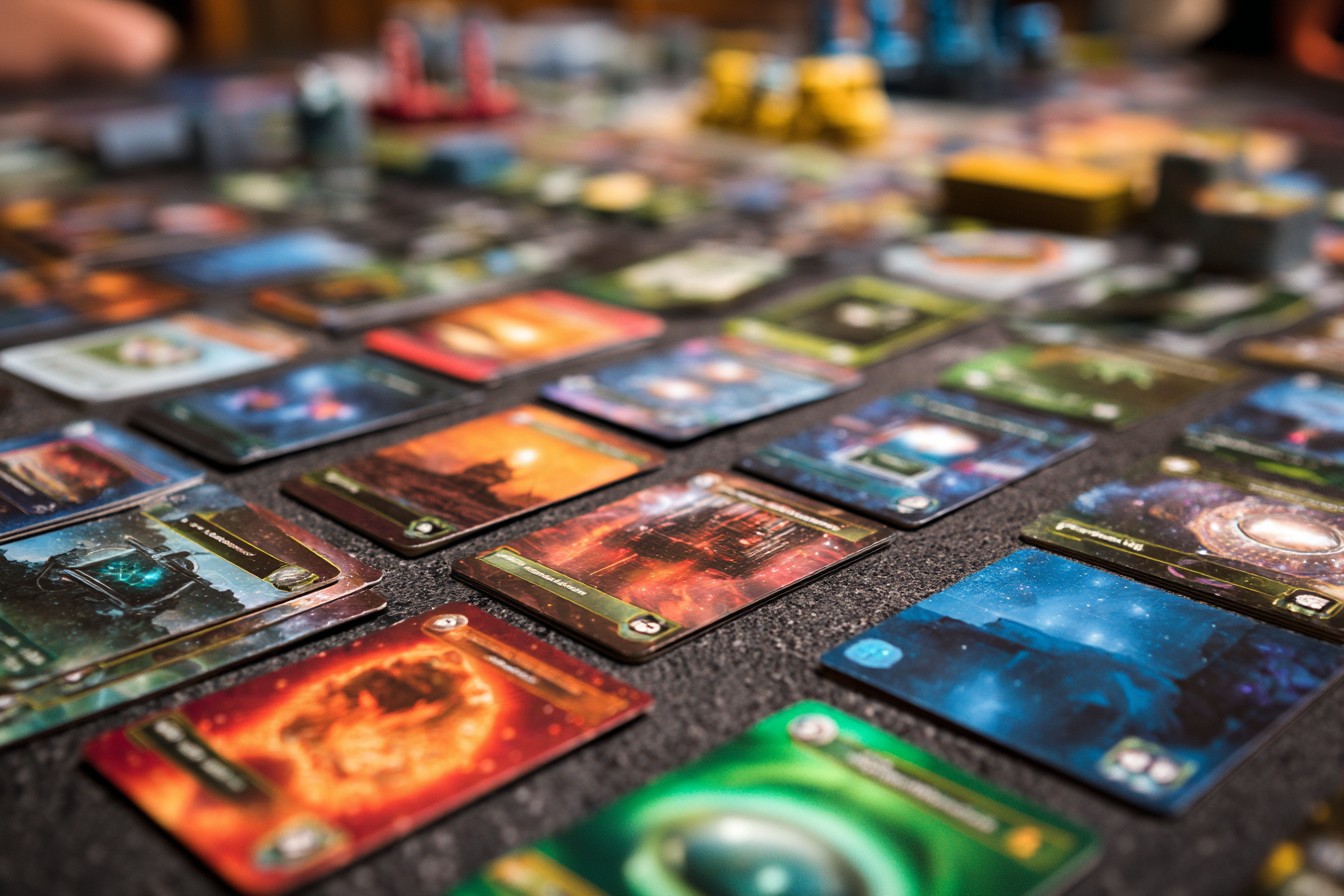I can still vividly recall my first real “aha” moment with Race for the Galaxy. It was probably my seventh or eighth game, playing with Linda and our friends Steve and Rachel at our regular Friday night session. I’d been drafting cards that seemed individually powerful—a hodgepodge of military worlds, developments, and production planets—when Rachel laid down a sequence that began with Desperate Mercenaries, followed by New Military Tactics and drooped with Imperium Lords a couple of turns later. The synergy was immediately apparent as she rapidly expanded her tableau through military conquest while the rest of us struggled to keep pace with our more resource-intensive settlements.
“You’re not just playing good cards,” she explained after thoroughly trouncing us, “you’re building an engine where every card amplifies the others.” That insight completely transformed my approach to the game. Now, after 150+ plays (conservatively estimated—I stopped logging individual games years ago), I’ve developed what I consider a reasonably sophisticated understanding of the card synergies that create those specialized economy engines that separate the casual players from the serious contenders.
My gaming group has a running joke about my “Race face”—the particular expression I apparently make when I’m analyzing my starting hand, eyes slightly narrowed, head tilted just so. “David’s calculating card probabilities again,” Linda will announce to the table when she spots it. They tease, but that analytical approach has led to a win rate I’m rather proud of, though I wouldn’t dare mention the precise percentage for fear of never being invited to play again.
The fundamental principle that guides effective engine building in Race for the Galaxy is what I call “strategic coherence”—ensuring that every card in your tableau contributes to a unified economic approach rather than representing isolated points of value. This might seem obvious in retrospect, but I’ve watched countless experienced gamers fall into the trap of drafting “good cards” without considering how they integrate into their overall strategy, ending up with tableaus that are collections of strong individual cards rather than synergistic engines.
This coherence principle crystallized for me during a game where I’d drafted what seemed like powerful cards from three different strategic directions—some military worlds, a couple of production planets, and a few consume-focused developments. Despite having what appeared to be a strong tableau in terms of raw card count and diversity, I was soundly defeated by Pete, whose tableau was smaller but perfectly aligned around a production-consumption engine that generated both cards and victory points with remarkable efficiency. That game taught me that strategic focus almost always outperforms diverse “good stuff” approaches in Race for the Galaxy.
Starting hand evaluation establishes the foundation for your strategic direction and deserves careful consideration rather than reactive drafting. Those initial six cards often contain seeds of potential engines, and identifying which synergies to pursue versus which to discard shapes your entire game trajectory. I’ve found that successful players frequently discard seemingly powerful individual cards if they don’t align with their emerging strategic direction, prioritizing coherence over isolated efficiency.
I remember watching Steve’s approach evolve over several months of regular play. Initially, he struggled to discard any card with significant point value or powerful individual abilities. Over time, he developed the discipline to ruthlessly cull his hand of anything that didn’t contribute to his chosen engine type, even if that meant discarding six-cost developments or rare military worlds. His win rate improved dramatically with this more focused approach, demonstrating the value of strategic discipline in hand management.
The specialized economy engines in Race for the Galaxy broadly fall into a few archetypal categories: military conquest, produce-consume cycles, development chains, and exploration engines. While hybrid approaches can sometimes succeed, I’ve found that the most consistently powerful tableaus maintain clear focus on one primary engine type while incorporating supporting elements from others only when they directly enhance the core strategy.
This categorization became particularly useful during a tournament setting (yes, I occasionally play Race competitively, which Linda finds endlessly amusing), where I found myself facing opponents of varying experience levels. Against less experienced players, I could reliably succeed with a straightforward produce-consume strategy focused on generating consistent victory points each cycle. Against more sophisticated opponents, I needed to carefully observe their initial plays to identify their engine type, then either race to complete my engine faster or pivot to a strategy that specifically countered their approach.
Military conquest engines center around worlds that can be settled through military power rather than payment, supported by developments that either increase military strength or provide benefits for military worlds. The classic military engine begins with early military worlds like Rebel Outpost or Alpha Centauri, builds through mid-game military boosting developments like New Military Tactics or Imperium Cloaking Technology, and culminates in high-value military worlds like Rebel Freedom Fighters or Imperium Lords.
My most successful military engine came together during a game where my starting hand contained both Drop Ships and Contact Specialist. This combination allowed me to settle high-defense military worlds without needing additional military developments, accelerating my expansion phase significantly. By midgame, I had established enough military worlds to justify investments in Imperial Seat and Galactic Imperium, creating a tableau that generated substantial victory points from military settlements while my opponents struggled to establish their more resource-intensive engines. The key insight was recognizing that military engines are fundamentally about tempo—sacrificing some late-game point generation for rapid early expansion.
Produce-consume engines revolve around establishing production worlds that generate goods, paired with consumption powers that convert those goods into cards, victory points, or both. The most efficient produce-consume engines typically specialize in a specific good type, like Rare or Genes, with developments that provide bonuses for producing or consuming those specific goods. The ideal cycle creates a self-reinforcing loop where consumption powers generate resources that enable further expansion of production capacity.
During a particularly memorable game, I constructed what my gaming group now refers to as “the windmill”—a genes-focused production engine built around Alien Rosetta Stone World and Consumer Markets. This combination allowed me to produce and consume genes goods for both cards and victory points, creating an acceleration of resources that quickly overwhelmed my opponents’ more balanced approaches. What made this engine particularly effective was its focus on a single good type, which allowed me to maximize the efficiency of specialized consumption powers rather than diluting my tableau with different production types.
Development chains represent a distinct engine type that focuses less on cycles of production and consumption and more on creating cascading cost discounts that enable the rapid deployment of high-value developments. These engines typically begin with developments like Investment Credits or Development Team that reduce the cost of subsequent developments, creating chains that culminate in powerful six-cost developments like Galactic Federation or Pan-Galactic League.
My colleague Jim, who approaches games with remarkable strategic clarity, mastered this engine type before any of our regular group. While the rest of us were focused on traditional produce-consume cycles, he consistently constructed development-focused tableaus that seemed to explode with six-cost developments in the late game. The key insight he shared was prioritizing developments that specifically reduced costs for other developments, creating a snowball effect where each played development made subsequent ones incrementally more affordable. This approach sacrifices early-game point generation for devastating late-game scoring, often dropping multiple six-cost developments in the final rounds.
Exploration engines center around cards that manipulate the draw deck, provide bonuses for exploring, or offer benefits for specific card types drawn during exploration. While pure exploration strategies rarely succeed at high levels of play, exploration elements frequently support other engine types by providing the card flow necessary to find key engine components. Developments like Contact Specialist or Explorer Corps can transform exploration from mere card acquisition into a strategic advantage that fuels your primary engine.
During a game where the initial card distribution left me without clear direction, I pivoted to what began as an exploration-focused strategy built around Explorer Corps and Mining Conglomerate. The consistent card flow from exploration allowed me to identify and transition into a minerals production engine midgame, demonstrating how exploration can serve as both an early-game survival mechanism and a bridge to more focused strategies when your starting hand lacks clear synergies.
The pace of development creates interesting strategic considerations in engine construction. Some engines, particularly military conquest and exploration-focused approaches, prioritize rapid expansion of the tableau even at the cost of some strategic coherence. Others, like specialized produce-consume cycles or development chains, may progress more deliberately, prioritizing perfect synergy over raw tableau size. I’ve found that successful players adapt their pace to both their chosen engine type and the observed strategies of their opponents.
This pacing sensitivity became apparent during a series of two-player games with Linda, where we explored different engine types across multiple sessions. Her produce-consume engines consistently developed at a measured pace, carefully adding only planets and developments that enhanced her core strategy. My military-focused tableaus expanded more rapidly but sometimes suffered from reduced efficiency in the late game. Neither approach proved universally superior; rather, the optimal pace depended on both engine type and the specific cards available during each game.
The role selection mechanism in Race for the Galaxy creates another layer of strategic consideration for engine building. Beyond selecting phases that directly benefit your tableau, skilled players anticipate which phases opponents are likely to choose and construct engines that can capitalize on these “free” actions. Engines that can effectively piggyback on opponents’ role selections often gain significant efficiency advantages, essentially getting additional actions without spending selection opportunities.
My friend Rachel, who has perhaps the most intuitive grasp of game mechanics in our group, excels at this aspect of engine construction. Rather than building tableaus that function optimally when she selects specific phases, she deliberately creates engines that thrive regardless of which player selects which phase. Her produce-consume engines typically include develop abilities that activate during others’ development phases, and her military strategies incorporate production elements that generate goods when opponents select produce. This adaptable construction allows her engines to operate efficiently even when she’s focusing her own role selections on phases others might neglect.
Card counting and probability awareness represent more advanced aspects of engine construction that separate expert players from intermediates. With experience, you develop awareness of which key engine components remain in the deck, informing decisions about whether to pivot strategies mid-game or persist with your initial direction. While perfect tracking is impossible given the deck size, even approximate awareness of remaining card distributions can significantly inform strategic adjustments.
During a tournament game against particularly skilled opponents, I found myself with the beginnings of a rare elements production engine but missing key consumption powers to convert those goods into victory points. A less experienced player might have persisted with the production strategy, hoping to eventually draw appropriate consumption cards. Having played enough to roughly track card distributions, I recognized that most rare-specific consumption powers had likely already been drawn or discarded. This awareness prompted a strategic pivot toward a hybrid approach that incorporated military expansion alongside my existing production capacity, ultimately proving more successful than stubbornly pursuing an engine missing critical components.
The meta-game of Race for the Galaxy—how player tendencies and group dynamics affect strategic decisions—further complicates optimal engine construction. In groups where multiple players typically pursue military strategies, the competition for limited military worlds and developments may make production engines relatively more viable. Conversely, in groups where produce-consume cycles dominate, military approaches might face less competition for key cards. Recognizing these patterns allows for more effective engine selection based not just on card synergies but on expected competition for specific strategy types.
During a regular session with our Friday night group, I noticed that both Pete and Sarah had developed strong preferences for military-focused strategies over several weeks of play. Rather than competing directly for the same cards, I deliberately shifted toward a specialized development engine that could outpace their military expansions in the late game. This meta-strategic awareness proved more valuable than blindly pursuing what might have been marginally stronger synergies in my starting hand, demonstrating how understanding player tendencies can inform engine selection beyond pure card analysis.
The specific timing of transitioning from engine construction to victory point generation creates another strategic dimension in Race for the Galaxy. Early game focuses primarily on establishing engine components, mid-game on maximizing engine efficiency, and late-game on converting that efficiency into victory points. Recognizing the appropriate moment to shift from building to scoring separates experienced players from beginners, who often either score too early (before their engine reaches full potential) or too late (building past the point of diminishing returns).
My approach to this transition has evolved significantly over hundreds of plays. In early games, I tended to focus on engine building until the game-end trigger approached, often missing opportunities for mid-game point generation. With experience, I’ve developed a more nuanced understanding of when engines reach peak efficiency, typically transitioning to point generation when my tableau contains 9-12 cards depending on the specific engine type. This timing allows my engine to operate at near-optimal efficiency while maximizing the number of rounds available for converting that efficiency into victory points.
After all these games and all this analysis, perhaps the most important insight I’ve gained about engine building in Race for the Galaxy is that the perfect engine isn’t about incorporating every possible synergy, but about maintaining strategic coherence while adapting to the specific card distribution of each game. The players who consistently succeed aren’t those who rigidly pursue preset strategies but those who identify the strongest available synergies within their current card access and construct focused engines that maximize those specific interactions.
I still occasionally misjudge card probabilities or pursue synergies that prove less efficient than anticipated. But those mistakes have become rarer as I’ve developed a more intuitive understanding of how different card combinations interact to create economic engines. There’s something deeply satisfying about watching a well-constructed tableau click into perfect operation, each card amplifying the effects of others in a self-reinforcing cycle of efficiency.
And really, isn’t that elegant interaction between seemingly disparate parts what makes Race for the Galaxy so fascinating? The tension between specialization and adaptability creates decisions unlike any other game in my collection. Now if you’ll excuse me, I need to go convince Linda that we absolutely need to play “just one more quick game” before bed. I have a theory about Alien Research Team synergies that I’m dying to test.






Leave a Reply